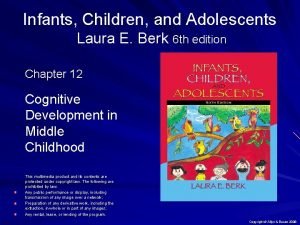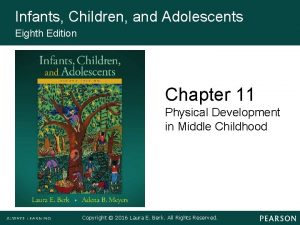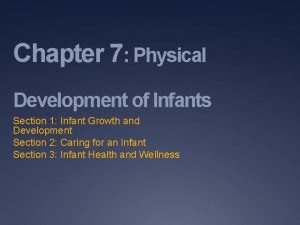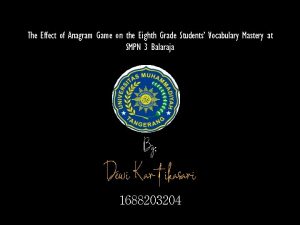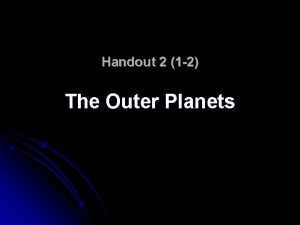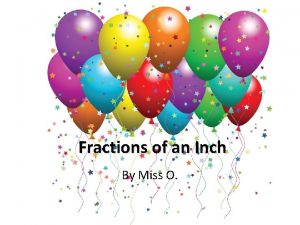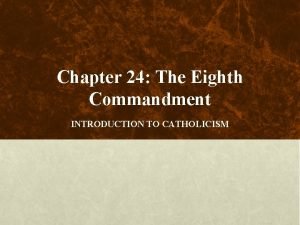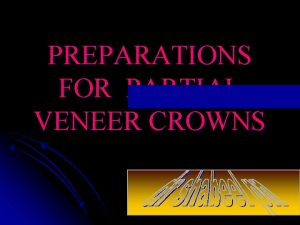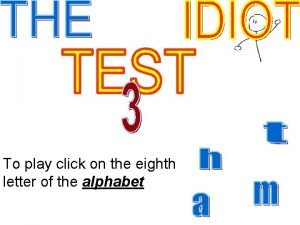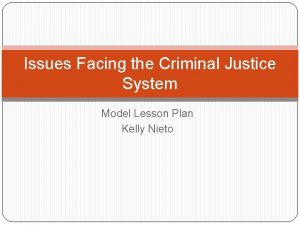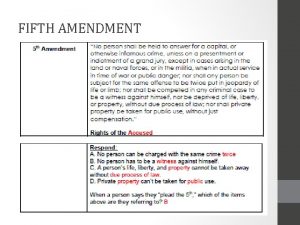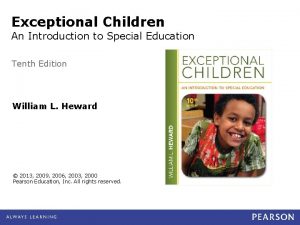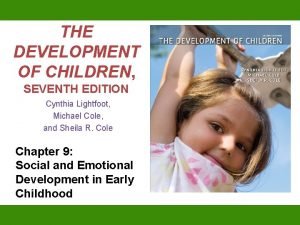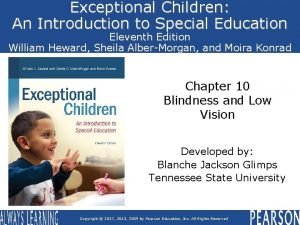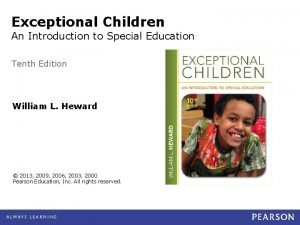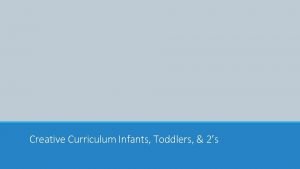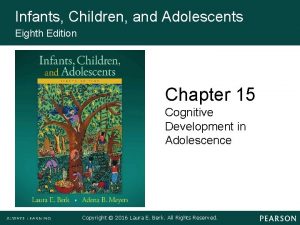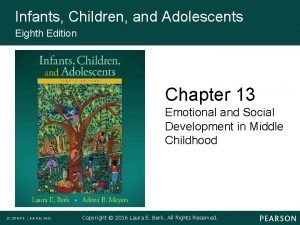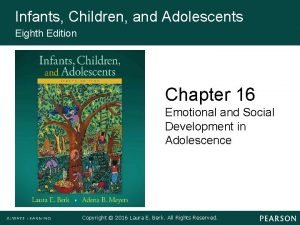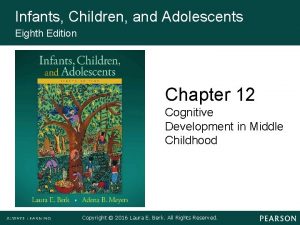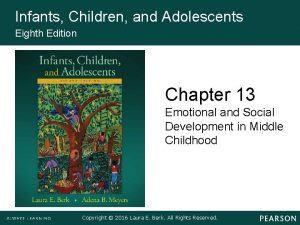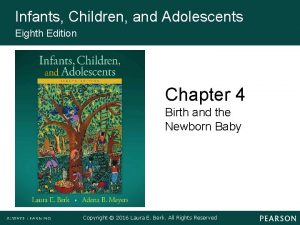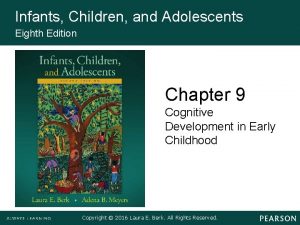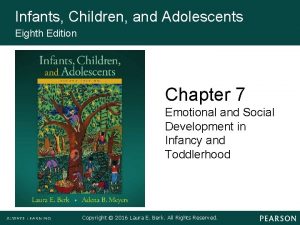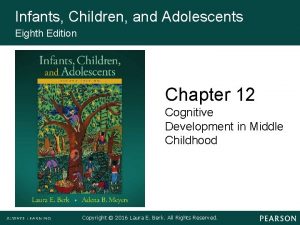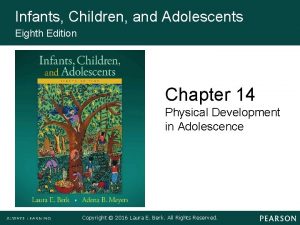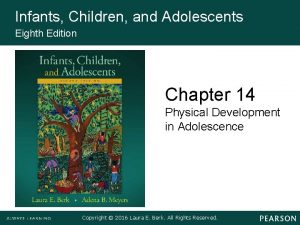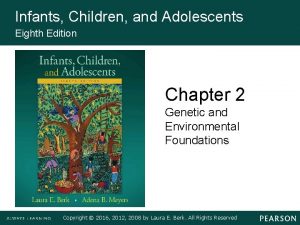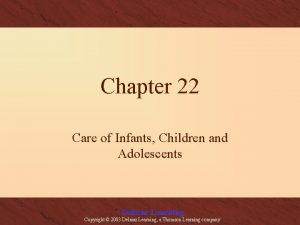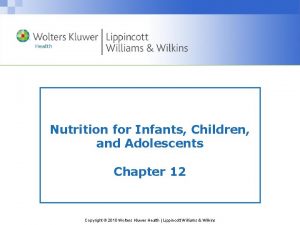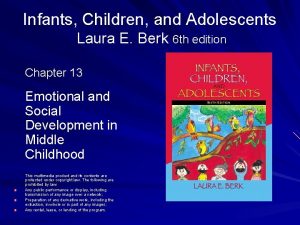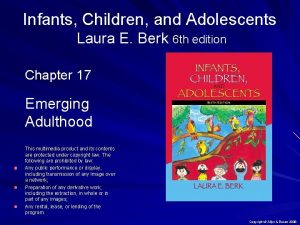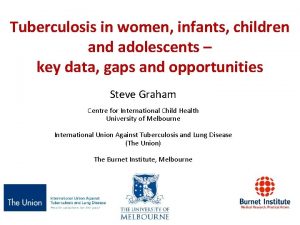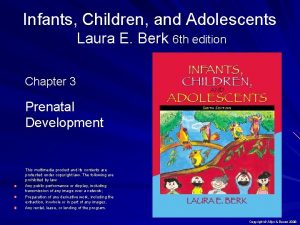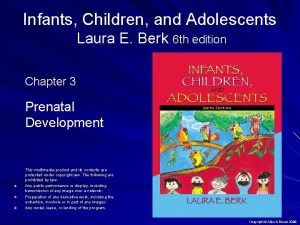Infants Children and Adolescents Eighth Edition Chapter 1




























- Slides: 28

Infants, Children, and Adolescents Eighth Edition Chapter 1 History, Theory, and Research Strategies Copyright © 2016 Laura E. Berk. All Rights Reserved

Learning Objectives (1 of 3) • • • 1. What is the field of child development, and what factors stimulated its expansion? 2. How is child development typically divided into domains and periods? 3. What theories influenced child development research in the mid-twentieth century? 4. Describe recent theoretical perspectives on child development. 5. Identify the stand taken by each major theory on the basic issues of child development. Copyright © 2016 Laura E. Berk. All Rights Reserved

Domains of Development Domain Physical Cognition Emotional and Social Changes in • Body size & proportions, appearance • Functioning of body systems, health • Perceptual & motor capacities • Intellectual abilities • Emotional communication • Self-understanding, knowledge about others • Interpersonal skills & relationships • Moral reasoning & behavior Copyright © 2016 Laura E. Berk. All Rights Reserved

Periods of Development Prenatal Infancy and Toddlerhood Early Childhood Middle Childhood Adolescence Emerging Adulthood Copyright © 2016 Laura E. Berk. All Rights Reserved Conception to birth Birth to 2 years 2 to 6 years 6 to 11 years 11 to 18 years 18 to mid- to late 20 s

Theory An orderly, integrated set of statements that • describes behavior. • explains behavior. • predicts behavior. Copyright © 2016 Laura E. Berk. All Rights Reserved

Basic Issues in Development 1. Continuous or discontinuous? 2. One course of development or many possible courses? 3. Relative influence of nature and nurture? Copyright © 2016 Laura E. Berk. All Rights Reserved

Continuous or Discontinuous Development Figure 1. 2 Copyright © 2016 Laura E. Berk. All Rights Reserved

Nature and Nurture Nature • Inborn, biological • Based on genetic inheritance Nurture • Physical and social world • Influences biological and psychological development Copyright © 2016 Laura E. Berk. All Rights Reserved

Stability vs. Plasticity? Stability • Individuals high or low in a characteristic remain so at later ages. • Early experience may have a lifelong impact. Plasticity • Change is possible, based on experiences. Copyright © 2016 Laura E. Berk. All Rights Reserved

Resilient Children • Personal characteristics • A warm parental relationship • Social support outside the immediate family • Community resources and opportunities Copyright © 2016 Laura E. Berk. All Rights Reserved

Historical Views of Childhood Medieval Era 16 th Century Childhood (to age 7 or 8) regarded as separate phase with special needs, protections Puritan “child depravity” views 17 th Century John Locke “tabula rasa” view; continuous development 18 th Century Jean-Jacques Rousseau “noble savages” view; natural maturation Copyright © 2016 Laura E. Berk. All Rights Reserved

Early Scientific Study of Development Evolutionary Darwin’s ideas of natural selection Theory and survival of the fittest are still influential. Normative Hall & Gesell: Age-related Approach averages based on measurements of large numbers of children Mental Binet & Simon: Early developers of Testing intelligence tests Movement Copyright © 2016 Laura E. Berk. All Rights Reserved

Freud’s Three Parts of the Personality Id Ego • • • Superego • • • Largest portion of the mind Unconscious, present at birth Source of biological needs & desires Conscious, rational part of personality Emerges in early infancy Redirects id impulses acceptably The conscience Develops from ages 3 to 6, from interactions with caregivers Copyright © 2016 Laura E. Berk. All Rights Reserved

Erikson’s Psychosocial Stages Basic trust v. mistrust Autonomy v. shame and doubt Initiative v. guilt Industry v. inferiority Birth– 1 year 1– 3 years 3– 6 years 6– 11 years Identity v. role confusion Intimacy v. isolation Generativity v. stagnation Integrity v. despair Adolescence Emerging adulthood Adulthood Old age Copyright © 2016 Laura E. Berk. All Rights Reserved

Behaviorism & Social Learning Classical Conditioning Operant Conditioning Social-Cognitive Approach Copyright © 2016 Laura E. Berk. All Rights Reserved Stimulus–Response Reinforcers and punishments Modeling Self-efficacy

Social Learning Theory Modeling or Observational Learning Cognition Personal Standards A baby claps her hands after her mother does; a teenager dresses like her friends. Stressed today; socialcognitive approach Children begin to believe their own abilities will help them succeed. Copyright © 2016 Laura E. Berk. All Rights Reserved

Limitations of Behaviorism and Social Learning Theory • Too narrow a view of important environmental influences • Underestimates children’s contributions • Bandura’s work is unique in that it grants children an active role in their own learning. Copyright © 2016 Laura E. Berk. All Rights Reserved

Piaget’s Stages of Cognitive Development Stage Sensorimotor Period of Development Birth– 2 years Preoperational 2– 7 years Concrete operational 7– 11 years Formal operational 11 years on Copyright © 2016 Laura E. Berk. All Rights Reserved Description • Infants “think” by acting on the world. • As a result, they invent ways of solving sensorimotor problems. • Preschoolers use symbols, develop language and make-believe play. • Thinking still lacks the logic of later stages. • Reasoning becomes logical and betterorganized. • Thinking is not yet abstract. • Abstract thinking enables use of hypotheses, inferences. • Adolescents no longer rely on real-world circumstances for logic problems.

Information Processing • Human mind as symbol-manipulating system • Researchers often design flowcharts to map problem-solving steps Copyright © 2016 Laura E. Berk. All Rights Reserved

Information Processing Figure 1. 3 (Based on Thornton, 1999) Copyright © 2016 Laura E. Berk. All Rights Reserved

Psychology Medicine Developmental Cognitive Neuroscience Copyright © 2016 Laura E. Berk. All Rights Reserved Biology

Developmental Neuroscience Uses: • Identify links between cognitive and social domains of development • Develop interventions for learning and behavioral problems Limitations: • Too dependent on brain properties; neglects environmental influences • Excessive emphasis on biological processes Copyright © 2016 Laura E. Berk. All Rights Reserved

Ecological Systems Theory Figure 1. 4 Copyright © 2016 Laura E. Berk. All Rights Reserved

Dynamic Systems Perspective Figure 1. 5 (Based on Fischer & Bidell, 2006) Copyright © 2016 Laura E. Berk. All Rights Reserved

Comparing Child Development Theories Continuous or Discontinuous? Discontinuous Theory Psychoanalytic perspective Behaviorism and Continuous social learning theory Piaget’s cognitive- Discontinuous developmental theory Information Continuous processing Copyright © 2016 Laura E. Berk. All Rights Reserved One Course of Development or Many? One course Many possible courses Relative Influence of Nature and Nurture? Both nature and nurture Emphasis on nurture One course Both nature and nurture

Comparing Child Development Theories Theory Ethology and evolutionary development psychology Vygotsky’s sociocultural theory Ecological systems theory Dynamic systems perspective Continuous or Discontinuous? Both continuous and discontinuous One Course of Development or Many? One course Relative Influence of Nature and Nurture? Both nature and nurture Both continuous Many possible and discontinuous courses Both nature and nurture Not specified Both nature and nurture Many possible courses Both continuous Many possible and discontinuous courses Copyright © 2016 Laura E. Berk. All Rights Reserved

Correlation Coefficients • Magnitude: Strength as indicated by a number between 0 and 1 – Closer to 1 (positive or negative) is a stronger relationship • Direction: Indicated by the sign (+ or –) – Positive: As one variable increases, so does the other – Negative: As one variable increases, the other decreases Copyright © 2016 Laura E. Berk. All Rights Reserved

Correlation Coefficients Figure 1. 6 Copyright © 2016 Laura E. Berk. All Rights Reserved
 Infants and children 8th edition
Infants and children 8th edition Infants, children, and adolescents 8th edition
Infants, children, and adolescents 8th edition Infants and children 8th edition
Infants and children 8th edition Infants and children 8th edition
Infants and children 8th edition Psychology eighth edition david g myers
Psychology eighth edition david g myers Psychology
Psychology Operations management eighth edition
Operations management eighth edition The fifth, sixth, seventh, and eighth amendments protect *
The fifth, sixth, seventh, and eighth amendments protect * Difference between dating and courting
Difference between dating and courting Lesson 9.1 intellectual advances in the first year
Lesson 9.1 intellectual advances in the first year Chapter 7 physical development of infants
Chapter 7 physical development of infants Anagram of eighth
Anagram of eighth Matching planet rings
Matching planet rings Quarter inch fraction
Quarter inch fraction 8th commandment catholic
8th commandment catholic Katja mahal
Katja mahal Wrench like grip in three fourth crown
Wrench like grip in three fourth crown Eighth amendment excessive bail
Eighth amendment excessive bail Eighth letter of the alphabet
Eighth letter of the alphabet Eighth amendment excessive bail
Eighth amendment excessive bail 9th amendment meaning
9th amendment meaning Exceptional children 10th edition
Exceptional children 10th edition The development of children 7th edition
The development of children 7th edition Gordon lightfoot ethnicity
Gordon lightfoot ethnicity Introduction of exceptional child
Introduction of exceptional child Exceptional children 10th edition
Exceptional children 10th edition Using mis 10th edition
Using mis 10th edition Zulily case study
Zulily case study Creative curriculum intentional teaching cards
Creative curriculum intentional teaching cards

